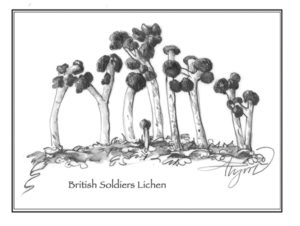By Rachel Sargent Mirus
As I stroll through the cemetery near my home on a snowy day, splashes of golden orange, bright as daylilies in July, pop from the gray stones. These patches are elegant sunburst lichens, which provide a vibrant example of just how colorful lichens can be. Lichens come in a wonderful range of colors, from the subtle pale green of old man’s beard to the brilliant yellow of goldspeck lichens. While these colors can be beautiful, they are also useful, as the pigments block harmful ultraviolet rays, allow lichens to absorb light as heat, and protect them from harmful microbes.

All lichens are a partnership of at least two microorganisms: a fungus and a photosynthesizer. Some of a lichen’s apparent color comes from the presence of pigments, or colored chemicals, within the protective skin. This skin is called a cortex and is created by the fungal partner along the lichen’s upper surface. Below this protective skin sits the photobiont: the photosynthesizing partner. If there is no special pigment in the cortex, lichens appear gray to grayish-green when dry.
When wet, however, lichens frequently change color dramatically, as the cortex becomes more transparent and the color of the photobiont shines through. Lichen photobionts can be different kinds and colors of algae or cyanobacteria, with their signature hues determined by their own set of photosynthesizing pigments, such as chlorophylls or carotenoids. Lichens with green algae partners often turn grass-green when wet. Cyanobacteria photobionts are blue-green to blue-gray, but lichens with cyanobacteria partners often appear black and jelly-like when wet.
Lichens living in exposed habitats are more likely to have deep colors and contain higher levels of pigment in their cortex than lichens living in shaded habitats, suggesting that their colors protect against sunlight. Lichen photobionts are vulnerable to excessive light, especially ultraviolet rays. The pigments found in the cortex of lichens can absorb or scatter ultraviolet wavelengths, shielding the photobiont like a sunscreen.
The most common brightly colored pigment found in the cortex of lichens is usnic acid, which gives lichens a pale yellowish-green hue. This is the classic color of beard lichens, those stringy clumps that hang from branches. Pale yellow usnic acid is best at blocking short wavelengths of ultraviolet light.
A category of pigments derived from pulvinic acid gives some lichens a brighter yellow color. The powdered sunshine lichen, which grows in frilly patches on both rock and wood, is a widespread northern example. The intensely yellow pulvinic acid pigments in their cortex block longer ultraviolet wavelengths.
Lichens that range from golden yellow to orange and bright red contain anthraquinone pigments. This is the pigment that gives the elegant sunburst lichen its summer-like hues even in the cold of winter. These pigments also give the British soldiers lichen its titular red tops.
Lichens containing melanin pigments will be shades of brown when dry. One example of melanin-containing lichen is rock tripe, whose large, brown flakes often grow on boulders and cliff sides. Melanin pigments act broadly, blocking a wider spectrum of light. Some lichen colors, particularly dusty white hues, come from physical structures on the lichen that scatter light, rather than from a chemical pigment. These structures can also protect against damaging levels of ultraviolet light.
Additional observations by lichenologists suggest that lichen colors may do even more than protect against sunlight. Lichens from northern regions with longer, colder winters tend to be darker than their hot-habitat counterparts, which may allow them to absorb light and keep that energy as warmth. Additionally, some lichen pigments, including usnic acid, have antimicrobial properties that can protect a lichen from attack by outside bacteria and fungi. Antimicrobial compounds likely give the slow-growing lichens a competitive edge in their harsh natural habitats.
While lichens are around all year, their small stature leaves them easily obscured by summer’s exuberant plant growth. It may be long months before the flowers in our gardens bloom. In the meantime, I’ll look for lichens’ bright colors shining through the snow.
Rachel Sargent Mirus lives in Duxbury, Vermont. Illustration by Adelaide Murphy Tyrol. The Outside Story is assigned and edited by Northern Woodlands magazine and sponsored by the Wellborn Ecology Fund of the New Hampshire Charitable Foundation: nhcf.org.




